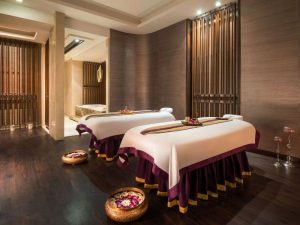
Defining the Ideal Relaxing Hotel Spa Experience

A truly relaxing hotel spa experience transcends a simple pampering session; it’s a holistic journey designed to rejuvenate the mind, body, and spirit. It’s about creating an environment where stress melts away and a sense of profound calm washes over you. This is achieved through a careful orchestration of atmosphere, sensory details, and thoughtful amenities.The atmosphere of an ideal relaxing spa is one of serene tranquility.
Soft, diffused lighting avoids harsh shadows, creating a sense of gentle warmth. Subdued, calming music, perhaps nature sounds or ambient melodies, plays softly in the background, never overpowering conversation but subtly enhancing the peaceful ambiance. The décor is minimalist yet elegant, featuring natural materials like wood, stone, and bamboo, with a calming color palette of muted greens, blues, and earth tones.
This intentional design fosters a sense of escape and encourages a slower pace.
Sensory Elements Contributing to Relaxation
The sensory experience is paramount in crafting a truly relaxing spa environment. Sight plays a significant role; the spa should be visually appealing, with soothing colors, calming artwork, and perhaps views of nature if possible. The gentle sounds of trickling water, soft music, or even the quiet hum of the spa itself contributes to a peaceful atmosphere. Aromatherapy, using essential oils with calming scents like lavender, chamomile, or sandalwood, creates a sense of olfactory tranquility.
Finally, the sense of touch is crucial; soft towels, plush robes, comfortable seating, and the gentle touch of a skilled massage therapist all contribute to a feeling of deep relaxation. The overall effect should be one of harmonious sensory stimulation, creating a holistic experience that soothes and rejuvenates.
Essential Spa Amenities Enhancing Relaxation
The following table Artikels essential amenities that elevate the relaxation experience, categorized by type and highlighting their specific benefits:
| Amenity Type | Specific Amenity | Description | Relaxation Benefit |
|---|---|---|---|
| Ambiance | Dimmable lighting | Allows for adjustment to suit individual preferences, creating a customizable level of calm. | Reduces visual stimulation and promotes a sense of peace. |
| Aromatherapy | Lavender essential oil diffuser | Diffuses calming scents throughout the spa area. | Promotes relaxation and reduces stress and anxiety. |
| Hydrotherapy | Whirlpool bath | Offers a warm, buoyant soak that eases muscle tension. | Relieves muscle aches and promotes overall relaxation. |
| Sensory Stimulation | Water features (e.g., fountains) | Provides a gentle, calming auditory and visual experience. | Creates a peaceful and tranquil environment, reducing stress. |
| Comfort | Plush robes and slippers | Provides a luxurious and comfortable experience. | Enhances the feeling of being pampered and cared for. |
| Treatment Options | Variety of massage therapies | Offers options to address specific needs, such as deep tissue massage for muscle pain or aromatherapy massage for stress relief. | Provides targeted relief and enhances overall well-being. |
| Refreshments | Herbal teas and infused water | Offers hydrating and calming beverages. | Supports hydration and contributes to a sense of well-being. |
Spa Treatment Options for Relaxation
Our spa offers a curated selection of treatments designed to melt away stress and promote deep relaxation. Each treatment utilizes high-quality products and techniques to deliver a truly rejuvenating experience, leaving you feeling refreshed and revitalized. We believe that relaxation is a journey, not a destination, and our treatments are carefully crafted to guide you on that path.
Swedish Massage
Swedish massage is a classic technique known for its gentle, flowing strokes. The therapist uses long, gliding movements along with kneading, circular friction, and tapping to relieve muscle tension, improve circulation, and promote relaxation. This type of massage is ideal for those seeking a soothing and calming experience, perfect for relieving everyday stress and promoting a sense of overall well-being.
The rhythmic nature of the strokes can induce a state of deep relaxation, reducing anxiety and promoting restful sleep.
Deep Tissue Massage
Unlike the lighter touch of a Swedish massage, deep tissue massage targets deeper layers of muscle and connective tissue. This technique uses slower, more deliberate strokes to release chronic muscle tension and address areas of pain or stiffness. While not as immediately relaxing as a Swedish massage, the long-term benefits are significant. Deep tissue massage can improve posture, increase range of motion, and alleviate persistent pain, contributing to a greater sense of physical and mental well-being in the long run.
The release of tension can lead to a feeling of profound relaxation once the treatment is complete.
Aromatherapy Massage
Aromatherapy massage combines the benefits of massage therapy with the therapeutic properties of essential oils. These oils, derived from plants, are carefully selected to promote relaxation, reduce stress, and enhance mood. Lavender, chamomile, and sandalwood are commonly used for their calming effects. The therapist incorporates the chosen oils into the massage, allowing their aromas to further enhance the relaxation response.
The combined effects of massage and aromatherapy create a deeply immersive and calming experience, promoting a sense of tranquility and peace. This holistic approach addresses both the physical and emotional aspects of stress reduction.
Hot Stone Massage
Hot stone massage utilizes smooth, heated stones placed strategically on the body to provide deep, penetrating heat. This heat helps to relax muscles, increase circulation, and relieve tension. The warmth of the stones creates a soothing sensation, allowing the therapist to work more deeply into the muscles without causing discomfort. The combined effects of heat and massage create a deeply relaxing and therapeutic experience, promoting both physical and mental relaxation.
This treatment is particularly effective in relieving muscle soreness and stiffness.
Creating a Relaxing Atmosphere in Hotel Rooms
Transforming a hotel room into a sanctuary of tranquility requires careful consideration of design elements that promote relaxation and rejuvenation. The goal is to create a space that feels both inviting and calming, allowing guests to unwind and escape the stresses of daily life. This involves a holistic approach, encompassing the visual, tactile, and even olfactory aspects of the room’s design.The creation of a peaceful environment hinges on the thoughtful selection of lighting, color palettes, and textures.
These elements work synergistically to influence mood and perception, setting the stage for a truly restful experience. Subtle shifts in ambiance, achieved through the strategic manipulation of these design elements, can profoundly impact a guest’s overall sense of well-being.
Lighting Design for Relaxation
Appropriate lighting is paramount in establishing a relaxing atmosphere. Harsh, overhead lighting should be avoided in favor of softer, diffused illumination. Think warm, inviting light sources such as strategically placed table lamps with soft shades, floor lamps emitting a gentle glow, or even integrated LED lighting systems that can be dimmed to create a soothing ambiance. The avoidance of bright, white light is crucial; instead, opting for warmer tones of light, mimicking natural daylight, can help to promote relaxation and improve sleep quality.
For example, a bedside lamp with a warm-toned bulb, providing just enough light for reading before sleep, can significantly contribute to a restful night.
Color Palettes and Their Impact on Mood
The color scheme of a hotel room significantly influences the mood and atmosphere. Earthy tones, such as muted greens, soft blues, and warm browns, are particularly effective in creating a sense of calm and serenity. These colors evoke a connection with nature, promoting feelings of peace and tranquility. Conversely, vibrant or intensely saturated colors should be used sparingly, as they can be stimulating and potentially disruptive to relaxation.
Consider a calming blue-grey on the walls, complemented by natural wood furniture and beige linens. This palette creates a soothing, harmonious environment.
The Role of Texture in Creating a Peaceful Space
Texture plays a crucial role in creating a tactile experience that enhances relaxation. Soft, plush textiles, such as high-thread-count linens, fluffy towels, and comfortable throws, invite guests to sink in and unwind. The incorporation of natural materials, such as wood, stone, or bamboo, adds to the sense of calm and grounding. Consider the contrast between the smooth, cool surface of a marble bathroom countertop and the soft, warm embrace of a plush bathrobe.
This interplay of textures adds depth and interest to the room while promoting a sense of comfort and ease.
The Impact of Specific Room Features
Comfortable bedding is undeniably essential for a restful sleep. High-quality mattresses, plush pillows, and luxurious linens are investments that significantly enhance the guest experience. The feel of cool, crisp sheets against the skin contributes significantly to relaxation. Aromatherapy diffusers, subtly releasing calming scents such as lavender or chamomile, further enhance the ambiance. The gentle, consistent diffusion of these fragrances promotes relaxation and can aid in improving sleep quality.
These subtle additions create a sensory experience that contributes to an overall sense of well-being.
Enhancing the Guest Experience Through Personalized Service

Personalized service is the cornerstone of a truly memorable and relaxing hotel and spa experience. It transcends simply meeting guest expectations; it’s about anticipating needs and exceeding them, creating a sense of individual care and attention that fosters a profound sense of well-being. This proactive approach transforms a simple stay into a personalized retreat, leaving guests feeling refreshed, rejuvenated, and deeply satisfied.By understanding and responding to individual guest preferences, hotels and spas can cultivate loyalty and generate positive word-of-mouth referrals.
This attentive approach isn’t merely about luxury; it’s about creating an environment where guests feel valued and understood, contributing significantly to their overall relaxation and enjoyment. The goal is to create a seamless and intuitive experience, where every detail contributes to a feeling of ease and comfort.
Anticipating Guest Needs and Providing Proactive Support
Understanding guest preferences begins even before arrival. Analyzing booking information – such as travel history, special requests, and any notes made during the reservation process – allows staff to anticipate needs and personalize the experience from the moment a guest steps into the hotel. For example, if a guest has previously requested a specific type of pillow or a particular room view, these preferences can be proactively addressed.
Similarly, if a guest is celebrating a special occasion, a small, thoughtful gesture like a complimentary bottle of champagne or a fruit basket can significantly enhance their stay. Regularly reviewing guest feedback and utilizing customer relationship management (CRM) systems helps identify trends and preferences, enabling proactive service improvements. Proactive communication, such as sending pre-arrival emails with details about the hotel and spa facilities, along with personalized recommendations tailored to the guest’s interests, demonstrates care and attention to detail.
Examples of Personalized Touches that Elevate the Guest Experience
Personalized touches can be subtle yet impactful. Imagine a guest arriving after a long journey; a chilled glass of water and a refreshing towel waiting in their room immediately conveys a sense of welcome and care. Offering a customized spa treatment based on the guest’s preferences and needs, perhaps incorporating their favorite essential oils or focusing on specific areas of tension, elevates the spa experience.
Remembering a guest’s name and using it throughout their stay fosters a sense of connection and personal attention. Small gestures, such as leaving a handwritten welcome note or arranging for their preferred reading material to be in their room upon arrival, demonstrate genuine care. For guests with dietary restrictions or allergies, proactively providing tailored meal options showcases attentiveness and consideration.
Even a simple personalized turndown service with a small treat, such as locally sourced chocolates or a comforting herbal tea, can make a significant difference. These seemingly small details collectively contribute to a feeling of being truly valued and cared for, resulting in a profoundly relaxing and memorable stay.






